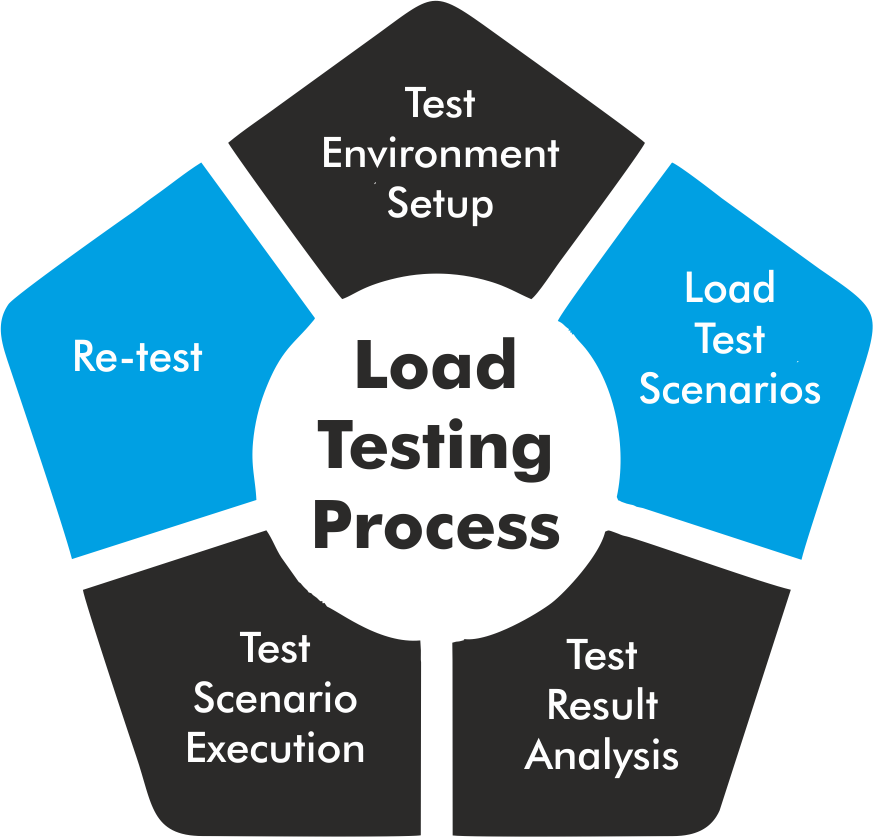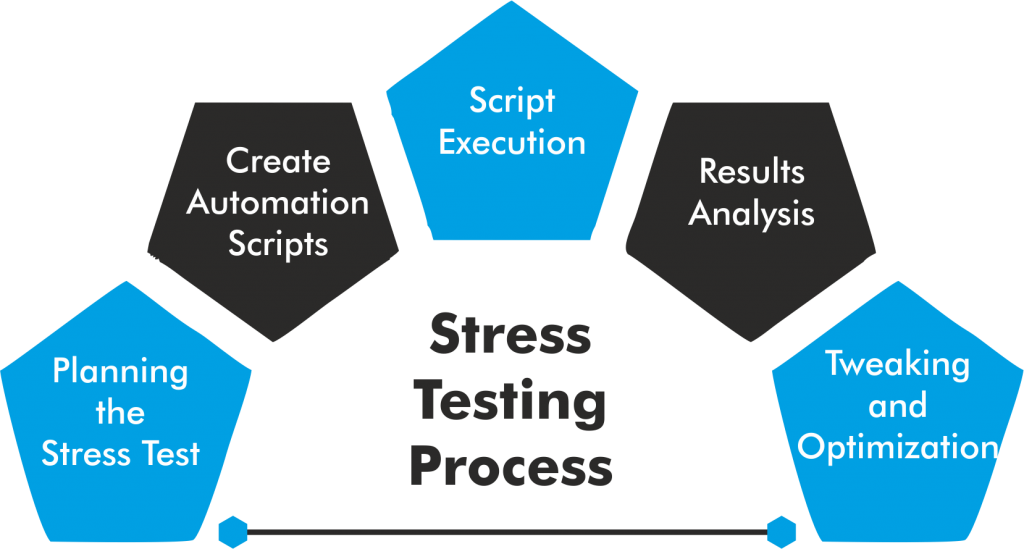Load and Stress Testing
Load Testing Services

Load Testing
Load testing is a type of performance testing that determines how well a system, software product, or software application performs under real-world load conditions. Load testing, in essence, determines how a programme behaves when several users use it at the same time. It is the system’s responsiveness under various load situations. Load testing is performed for both regular and excessive load conditions.
SoftWorks Quality Assurance ensures that your programmes work exactly as you envisioned. Our testing strategy combines tried-and-true ideas and methodologies with the best technologies and techniques to provide a masterful application.
The objective of load testing is
- To increase a software application’s running capability.
- To determine whether the most recent infrastructure is capable of running the software programme.
- To test the application’s long-term viability under extreme user load.
- To determine the total number of users who can access the application at the same time.
- To determine the application’s scalability.
- To enable additional users to use the application.
SoftWorks QA’s significantly experienced and efficient team provides end-to-end Load testing solutions for the Application optimal operation and quality management. We ensure that your software is fully functional and ready for release by emphasizing on client expectations and requirements.
By carrying extensive Load Testing for your software you can easily evaluate the compliance of a system or component with a specified set of functional requirements
Built a Dedicated Test Environment:
First, construct a dedicated test environment setup for performing load testing. It ensures that testing is carried out correctly.
Load Test Scenarios:
The second stage is to build load test scenarios. Then, for an application, load testing transactions are determined, and data is prepared for each transaction.
Execution of Test Scenarios:
The load test scenarios that were prepared in the previous phase are now executed. To acquire the information, many measurements and metrics are gathered.
Analysis of Test Results:
The results of the testing are analysed, and various recommendations are given.
Re-test:
If the test fails, the test is repeated in order to obtain the proper result.
Metrics of Load Testing
Metrics are used to determine the performance of load testing under various conditions. It indicates how accurately the load testing is operating under various test circumstances. It is often performed following the compilation of load test scripts/cases. There are numerous measures for evaluating load testing. Some examples are provided below.

Average Response Time
It indicates the average time required to respond to a request produced by clients, customers, or users. It also shows the application's speed based on the time it takes to react to all requests generated.

Requests Per Second
This value indicates how many requests are sent to the application server per second. The requests could be for anything, such as graphics, documents, web pages, articles, or other resources.

Error Rate
The Error Rate is expressed as a percentage and denotes the number of errors that happened during the requests in relation to the total number of requests. These errors are typically thrown when the programme is unable to handle the request at the specified time or for other technical reasons. When the mistake rate continues to rise, the application becomes less efficient.

Concurrent Users
This measure is used to count the number of users who are actively present at any given time. It just maintains track of how many people visit the application at any given time without making any requests in the application. This allows us to simply determine when a large number of users are visiting the application or website.

Throughput
This measure is used to determine the amount of bandwidth required during load programs or tests, as well as the amount of data used to check the request that passes between the user server and the application main server. Kilobytes per second is the unit of measurement.

Peak Response Time
Peak Response Time is the amount of time it takes to handle a request. It also aids in determining the duration of the peak time (the longest period) at which the request and response cycle is handled, as well as determining which resource is taking the longest time to react to the request.
Load Testing Tools


Advantages of Load Testing
- Load testing enhances the sustainability of the system or software application.
- It improves the scalability of the system or software application.
- It helps in the minimization of the risks related to system downtime.
- It reduces the costs of failure of the system.
- It increases customer’s satisfaction.
Stress Testing
Stress testing is a software testing approach that determines the robustness of software by stressing it beyond its regular operating limitations. Stress testing is essential for critical software, but it is used for all types of software. Stress testing focuses on resilience, availability, and error handling under high load rather than what is correct behaviour in normal circumstances. Stress testing is a sort of software testing that checks the system’s stability and reliability. This test focuses on the system’s robustness and error handling under extremely high load situations. It even goes beyond the standard operating point to examine how the system performs under extreme settings. Stress testing is done to ensure that the system will not crash during a crunch. Stress testing is also known as Endurance Testing or Torture Testing.

Characteristics of Stress Testing
- Stress testing examines the system’s behavior following a failure.
- Stress testing ensures that the system will recover after a failure.
- It determines if the system functions properly under abnormal conditions.
- When the system is under stress, it ensures that relevant error messages are displayed.
- It ensures that unexpected failures do not compromise security.
- It checks to see if the system saved the data before crashing.
Server-client Stress Testing:
In this type of stress testing, testing is performed on all clients connected to the server.
Product Stress Testing:
Product stress testing focuses on detecting problems in a software product related to data locking and blocking, network challenges, and performance congestion.
Transaction Stress Testing:
Transaction stress testing is done on one or more transactions that take place between two or more applications. It is performed to fine-tune and optimize the system.
Systematic Stress Testing:
Systematic stress testing is a type of integrated testing that is used to execute tests on numerous systems running on the same server. It is used to find bugs where one application’s data is interfering with another’s data.
Analytical Stress Testing:
Analytical stress testing is used to put the system through its paces with anomalous parameters or conditions that are unlikely to occur in a real-world setting. It is used to detect flaws in uncommon settings such as a high number of users logging in at the same time or a database being offline when accessed via a website.
Stress Testing Tools



Metrics of Stress Testing

Pages Per Second:
The number of pages requested per second and the number of pages loaded per second.

Pages Retrieved:
The average time it takes to retrieve all information from a specific page.

Byte Retrieved:
The average time required to retrieve the first byte of data from the page.

Transaction Response Time:
The average amount of time required to load or complete transactions between apps.

Failure of System Attempts:
It keeps track of the number of failed system attempts.

Transactions per Second:
It counts the number of transactions loaded successfully per second as well as the number of failures.

Rounds:
It counts the number of test or script conditions successfully run by clients and the number of rounds failed.

Connection Failure:
It counts the number of times the customer encountered connection failure in their system.
Advantages of Stress Testing
Stress testing analyses how the system behaves after failure and guarantees that it recovers fast.
Stress testing assures that system breakdown does not compromise security.
Stress testing forces the system to function properly in both normal and abnormal settings.
Why SoftWorks QA ?
Dedicated Team
Best software quality assurance personals at your service.
Timely delivery
Fast and efficient delivery results for software testing..
Clear communication
Expert staff for testing services & long-term engagements.
Flexible support
24x7 support to provide the best software testing services










